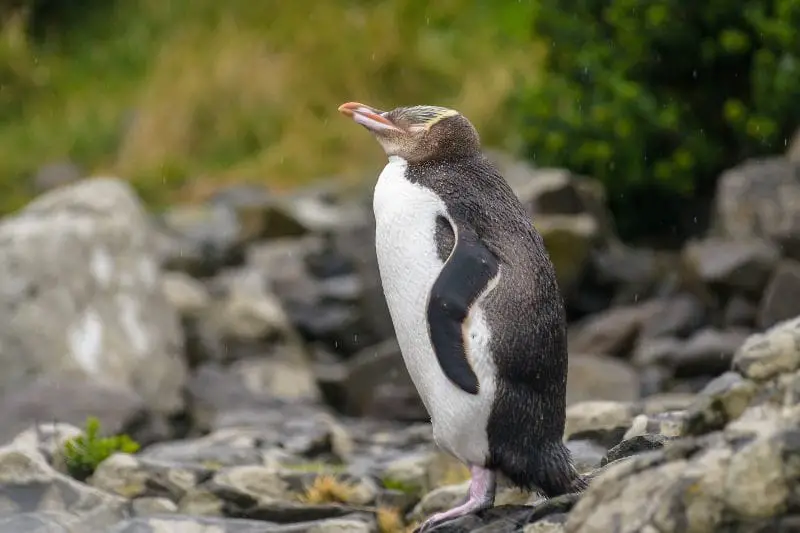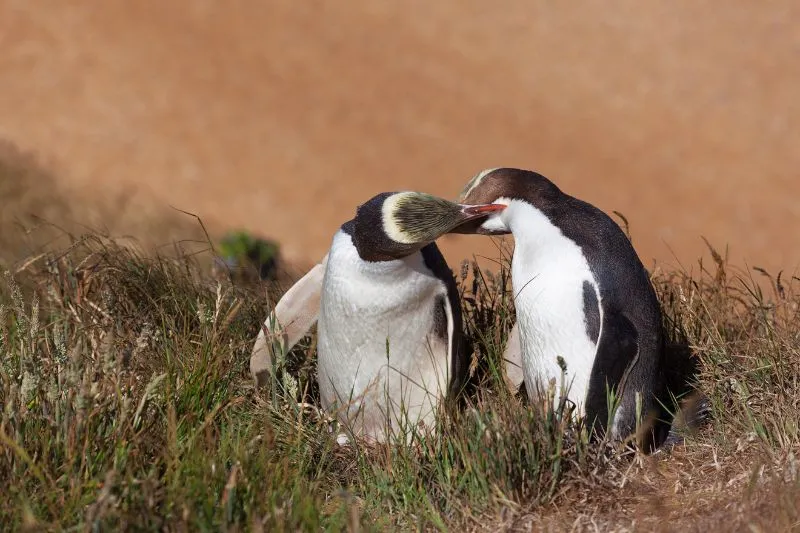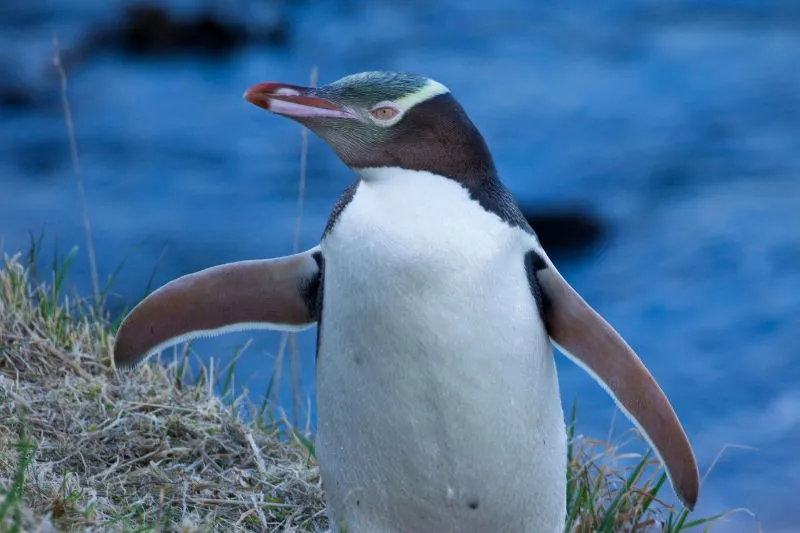Yellow-eyed penguins (Megadyptes antipodes), also known as Hoiho, are an endangered species of penguin native to New Zealand. With a population of fewer than 3,000 birds remaining, they are one of the rarest types of penguin.
In this article, we will explore some fascinating facts about Yellow-eyed penguins, including their habitat, diet, and conservation efforts being made to protect them.
1. The Yellow-eyed penguin is endemic to New Zealand
Yellow-eyed penguins breed on the southeast coast of New Zealand’s South Island and nearby Stewart Island. They tend to inhabit areas with forests or exotic vegetation so that they can keep their nests well concealed1 (source: IUCN).
They also inhabit some sub-antarctic islands which include the Auckland Islands and Campbell Island.

This graphic shows a map of where penguins live across the world.

2. The Yellow-eyed penguin is the only living member of the Megadyptes family
Each species of penguin falls into a family with closely related penguins that share similar traits. However, the Yellow-eyed Penguin is the only living member of its family, the Megadyptes penguins.
There may have previously been a sister species called the Waitaha penguin which occupied the mainland of New Zealand, limiting the Yellow-eyed penguin to the islands. However, the sister species likely became extinct around the 14th or 15th century when it would have been eaten by Polynesian settlers2 (source: Wikipedia).
Recent studies have shown that the Yellow-eyed penguin is closely related to the Eudyptes family, also known as crested penguins. The two families diverged around 15 million years ago3 (source: H. Pan, et al, Genomic data from Yellow-eyed penguin, 2019).
3. As the name implies, they are easily identifiable by their yellow eyes

It’s not hard to identify a Yellow-eyed penguin thanks to their bright yellow eyes and a unique yellow stripe in their feathers that runs around the back of their head from one eye to the other.
The rest of their face is also unique in that their chin, cheeks, and forecrown are black with yellow markings whilst the sides of their head are slightly brown.
4. The lifespan of a Yellow-eyed penguin is 15-20 years in the wild
The lifespan of a Yellow-eyed penguin in the wild is between 15-20 years old. This is about average for a penguin with most species living to around 20.
In captivity, penguins live a little longer, typically around 30 years although there have been documented cases of penguins living to the ripe old age of 40 in captivity. See our full article on how long penguins live for more details on this.
5. Their black and white feathers provide camouflage underwater

Penguins have a special coloring called countershading, which helps them blend into the water. They are white on their belly which makes it harder to spot from below when they are swimming as the white blends in with the light coming from above.
The black on their back makes them harder to spot them from above because it blends in with the darker waters below4 (source: H.M. Rowland, The Royal Society B Biological Sciences, Issue 364, 2008).
6. Fewer than 3,000 remain and they are endangered

Yellow-eyed penguins are classified as endangered by the IUCN due to threats such as disease, invasive predators, and industrial fishing having impacts on the already small population which is estimated between 2,600-3,000 mature individuals5 (source: IUCN).
In fact, in 2004, almost 60% of Yellow-eyed penguin chicks on the Otago Peninsula and in North Otago were killed by a new disease linked to an infection of Corynebacterium. This shows how vulnerable they are6 (source: M.R. Alley, et al, Kokako, Vol. 11, Issue 2, p.18, 2004).
Industrial fishing is the largest threat, which is when penguins are accidentally caught and killed in fishing nets. Other threats include fires in breeding areas, disease, disturbance by tourists, and introduced predators (more on this below)7 (source: IUCN).
7. They are above-average size at around 76cm tall
Yellow-eyed penguins are above average height for a penguin, coming in at around 76cm (30”) tall8 (source: The Illustrated Encyclopedia of Birds: The Definitive Reference to Birds of the World, C. M. Perrins). They usually weigh up to 6kg (3lbs) (source: Seaworld) which again is above average.
Below is a graphic showing how the size of different penguin species compares.

8. Their biggest predators are on land, not at sea
The natural predators of Yellow-eyed penguins are sharks, seals, sea lions, and barracuda9 (source: New Zealand Department of Conservation). These are similar predators to other species of penguins.
However, Yellow-eyed penguins are also threatened by introduced predators on land such as ferrets, stoats, dogs, and occasionally feral cats10 (source: IUCN).
These introduced predators often prey on chicks and can cause chick mortality to be as high as 63% when uncontrolled11 (source: Penguins: Natural History and Conservation), however, they rarely prey on adults.
9. Yellow-eyed penguins feature on the New Zealand currency

New Zealand might famously be associated with the kiwi, but they also have a special place in their heart for the Yellow Eyed Penguin. In 2019, they named it bird of the year, the first time a seabird won the award12 (source: Bird of the Year).
It has also featured on their currency, first on the reverse of the 1988 one-dollar coin13 (source: Coins Catalog) and then in 2015 it was added as a more permanent addition to their five-dollar bill as shown above.
10. A special salt gland allows them to consume seawater
Our next penguin fact is that they have a super orbital gland, commonly known as the salt gland, at the top of their skull, near their eye, which removes salt from their blood.
Yellow-eyed penguins need this because they spend most of their lives either at sea or around coastal areas of New Zealand where the only water available for consumption is saltwater but their kidney is not very efficient at processing salt.
The salt collected via the gland is excreted in water droplets through their nostrils by sneezing or shaking their head14 (source: Britannica). This means that penguins don’t need to worry about ingesting salt water as they catch and eat their prey out at sea.
11. Their diet is mainly fish

Penguins are carnivores that typically feed on fish and other sea creatures.
The diet of Yellow-eyed penguins is made up of 87% fish (by volume) with arrow squid making up the rest. The most common fish that they consume are sprat, red and blue cod, opal fish, c, and silversides.
They catch their prey on foraging trips where they typically head 12-20km offshore and dive into the sea to catch their prey. Usually swallowing it whole15 (source: Penguins: Natural History and Conservation).
12. Despite their loud call, they are very shy penguins
The Māori name for Yellow-eyed penguins is Hoiho (not to be confused with their name for horses; Hōiho) which translates as ‘noisy shouter’, mainly because of their loud call.
However, don’t be fooled by this, they’re actually very shy. If they see or hear humans as they come ashore, they’ll quickly turn around and swim back out to sea, leaving their chicks to go hungry. This is why many of the beaches near their nesting sites close early to prevent tourists from disturbing them16 (source: Lonely Planet).
These penguins value their privacy. Their nests (made of twigs, grass, and leaves) are well spread out, in well-concealed nesting sites, and often out of sight of one another17 (source: Penguins: Natural History and Conservation).



![Read more about the article 14 Humble Facts About Humboldt Penguins [#6 Will Change How You See Them]](https://polarguidebook.com/wp-content/uploads/2023/01/Humboldt-Penguin-2-300x200.jpg)
![Read more about the article 14 Magnificant Facts About Magellanic Penguins [#9 Will Surprise You!]](https://polarguidebook.com/wp-content/uploads/2023/01/Magellanic-penguins-group-300x200.jpg)
